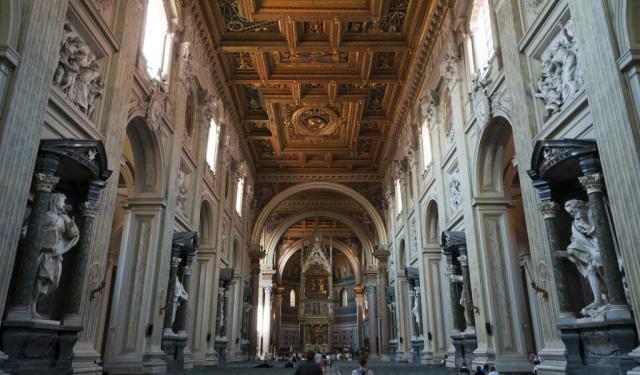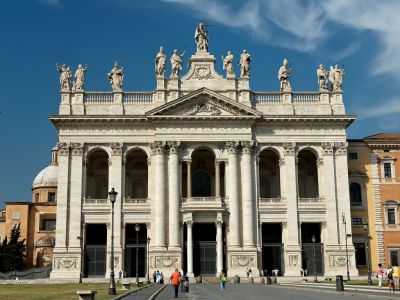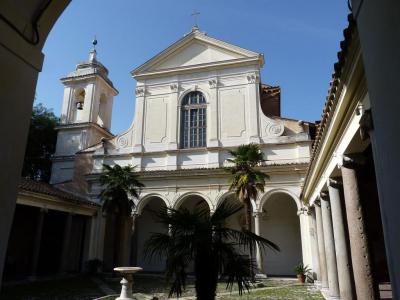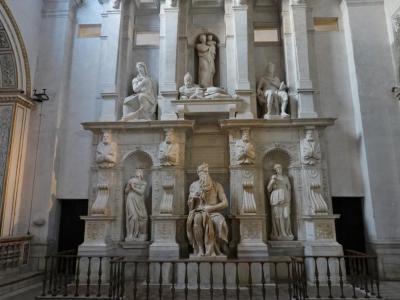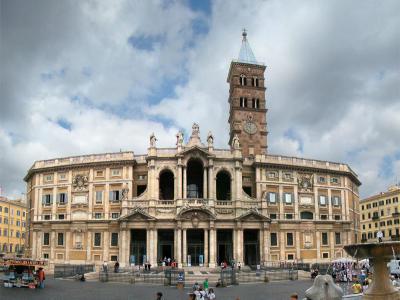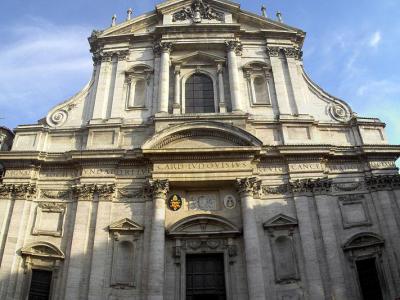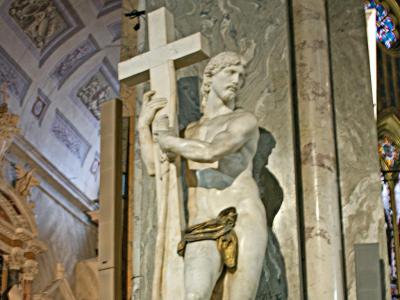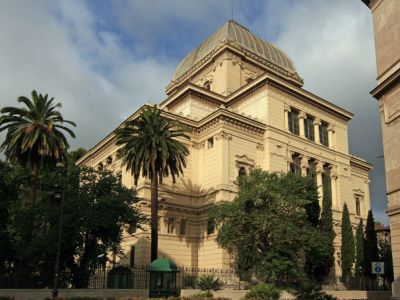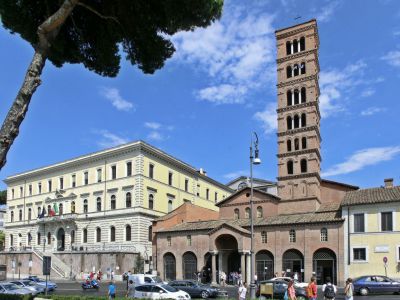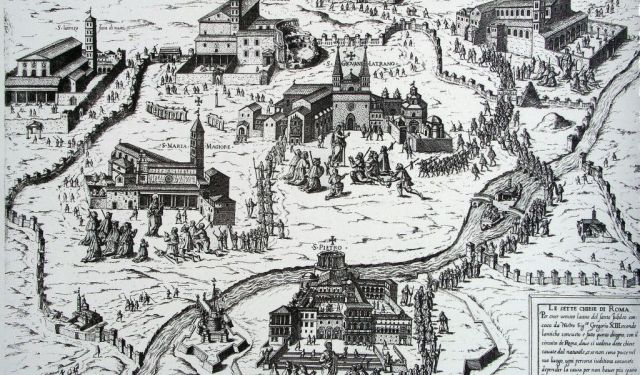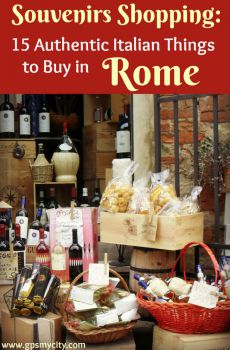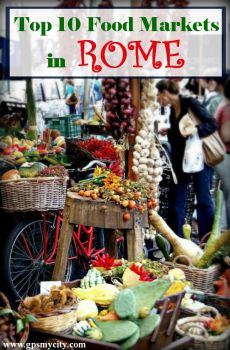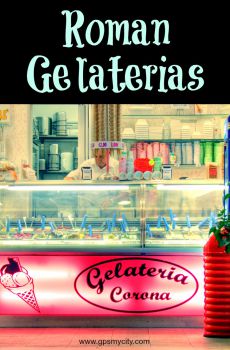Holy Sites Walking Tour (Self Guided), Rome
As the cradle of the Catholic Church, one of the world's largest organizations, Rome has a large number of valuable, sacred places of worship. Crowded with architectural splendors from different periods of time, each of its churches and basilicas represent a significant part of culture and history.
Take this self-guided walking tour to discover Rome's magnificent religious heritage, starting with the oldest and highest of the four papal basilicas, named after St. John in Lateran. Even before entering, you will be stunned by its magnificent façade and grandiose statues of Christ and the Twelve Apostles, created in the beginning of the 18th century by several prominent Italian sculptors.
Among other highlights is the San Pietro in Vincoli, again very beautiful and particular, though most of the attention will rightly be focused on the statue of Moses: impossible to fully describe in words, but there isn’t an art history book that doesn't mention it! Nearby Santa Maria Maggiore was the first basilica to be consecrated to Virgin Mary (in year 434 A.D.) and is one of the Seven Great Pilgrim Churches of Rome, which makes it very important and therefore a must-visit.
You will also pass by the baroque Church of St. Ignatius of Loyola and the ancient Pantheon, as well as lesser-known sights like Santa Maria sopra Minerva – the only true Gothic cathedral in Rome, which packs a large punch despite its small size.
For these and other places of worship packed with treasures, follow our walk and learn more about their history along the way.
Getting to Sight #1. The first tour stop (St. Peter's Square) can be reach by Bus: Bus: 23, 31, 49, 490, 40 Express and and 116 electric bus; Train: FL3, Metro: line A.
Take this self-guided walking tour to discover Rome's magnificent religious heritage, starting with the oldest and highest of the four papal basilicas, named after St. John in Lateran. Even before entering, you will be stunned by its magnificent façade and grandiose statues of Christ and the Twelve Apostles, created in the beginning of the 18th century by several prominent Italian sculptors.
Among other highlights is the San Pietro in Vincoli, again very beautiful and particular, though most of the attention will rightly be focused on the statue of Moses: impossible to fully describe in words, but there isn’t an art history book that doesn't mention it! Nearby Santa Maria Maggiore was the first basilica to be consecrated to Virgin Mary (in year 434 A.D.) and is one of the Seven Great Pilgrim Churches of Rome, which makes it very important and therefore a must-visit.
You will also pass by the baroque Church of St. Ignatius of Loyola and the ancient Pantheon, as well as lesser-known sights like Santa Maria sopra Minerva – the only true Gothic cathedral in Rome, which packs a large punch despite its small size.
For these and other places of worship packed with treasures, follow our walk and learn more about their history along the way.
Getting to Sight #1. The first tour stop (St. Peter's Square) can be reach by Bus: Bus: 23, 31, 49, 490, 40 Express and and 116 electric bus; Train: FL3, Metro: line A.
How it works: Download the app "GPSmyCity: Walks in 1K+ Cities" from Apple App Store or Google Play Store to your mobile phone or tablet. The app turns your mobile device into a personal tour guide and its built-in GPS navigation functions guide you from one tour stop to next. The app works offline, so no data plan is needed when traveling abroad.
Holy Sites Walking Tour Map
Guide Name: Holy Sites Walking Tour
Guide Location: Italy » Rome (See other walking tours in Rome)
Guide Type: Self-guided Walking Tour (Sightseeing)
# of Attractions: 11
Tour Duration: 3 Hour(s)
Travel Distance: 6.9 Km or 4.3 Miles
Author: audrey
Sight(s) Featured in This Guide:
Guide Location: Italy » Rome (See other walking tours in Rome)
Guide Type: Self-guided Walking Tour (Sightseeing)
# of Attractions: 11
Tour Duration: 3 Hour(s)
Travel Distance: 6.9 Km or 4.3 Miles
Author: audrey
Sight(s) Featured in This Guide:
- Arcibasilica di San Giovanni in Laterano (Archbasilica of Saint John in the Lateran)
- Basilica di San Clemente al Laterano (Basilica of Saint Clement)
- Basilica di San Pietro in Vincoli (Basilica of St. Peter in Chains)
- Basilica di Santa Maria Maggiore (Basilica of Saint Mary Major)
- Basilica di Santa Maria degli Angeli e dei Martiri (St. Mary of the Angels and the Martyrs)
- Chiesa di San Carlino alle Quattro Fontane (Church of St. Charles at the Four Fountains)
- Chiesa di Sant' Ignazio di Loyola (Church of St. Ignatius of Loyola)
- Pantheon
- Basilica di Santa Maria sopra Minerva (Basilica of Saint Mary above Minerva)
- Tempio Maggiore di Roma (Great Synagogue of Rome)
- Basilica di Santa Maria in Cosmedin (Basilica of Saint Mary in Cosmedin)
1) Arcibasilica di San Giovanni in Laterano (Archbasilica of Saint John in the Lateran)
Saint John's, not Saint Peter's, holds the distinction of being highest-ranking basilica in the world. Founded in 324, it is the oldest public church in the city of Rome, and the oldest basilica of the Western world.
Emperor Constantine commissioned the construction of this grand structure, predating the establishment of Saint Peter's, making it the primary ecclesiastical seat of the Pope. Throughout its history, the edifice has faced challenges such as vandalism, earthquakes, and fires, leading to extensive restorations in the 16th and 17th centuries. Notably, the interior was artfully designed by the renowned Baroque genius Borromini. Standing tall on the impressive facade are colossal statues representing the Twelve Apostles, Christ, John the Baptist, and the Virgin Mary.
While much of the structure has undergone restoration, fragments from earlier periods remain. Adorning the left portico is an ancient statue of Constantine, while the central portal has ancient bronze doors transferred from the Curia in the Roman Forum. Inside, the altar boasts a magnificent Gothic tabernacle, dating back to 1367, which is believed to house the revered heads of Saint Peter and Saint Paul. A captivating sight awaits in the last chapel of the left aisle, where a cloister adorned with 12th-century cosmatesque mosaics can be admired.
Just around the corner, Emperor Constantine's octagonal baptistery stands as one of Rome's oldest Christian structures. Despite multiple restorations, a 17th-century redecoration, and even a car bombing in 1993 associated with the Mafia, this baptistery has preserved its ancient form.
Tip: Don't miss the opportunity to visit the cloister behind the archbasilica. Although there is a small fee, it grants you access to a collection of authentic antiquities dating back to pre-Roman times, as well as a selection of intriguing Catholic relics.
Emperor Constantine commissioned the construction of this grand structure, predating the establishment of Saint Peter's, making it the primary ecclesiastical seat of the Pope. Throughout its history, the edifice has faced challenges such as vandalism, earthquakes, and fires, leading to extensive restorations in the 16th and 17th centuries. Notably, the interior was artfully designed by the renowned Baroque genius Borromini. Standing tall on the impressive facade are colossal statues representing the Twelve Apostles, Christ, John the Baptist, and the Virgin Mary.
While much of the structure has undergone restoration, fragments from earlier periods remain. Adorning the left portico is an ancient statue of Constantine, while the central portal has ancient bronze doors transferred from the Curia in the Roman Forum. Inside, the altar boasts a magnificent Gothic tabernacle, dating back to 1367, which is believed to house the revered heads of Saint Peter and Saint Paul. A captivating sight awaits in the last chapel of the left aisle, where a cloister adorned with 12th-century cosmatesque mosaics can be admired.
Just around the corner, Emperor Constantine's octagonal baptistery stands as one of Rome's oldest Christian structures. Despite multiple restorations, a 17th-century redecoration, and even a car bombing in 1993 associated with the Mafia, this baptistery has preserved its ancient form.
Tip: Don't miss the opportunity to visit the cloister behind the archbasilica. Although there is a small fee, it grants you access to a collection of authentic antiquities dating back to pre-Roman times, as well as a selection of intriguing Catholic relics.
2) Basilica di San Clemente al Laterano (Basilica of Saint Clement) (must see)
San Clemente is a most impressive archaeological site in Rome, renowned for its unique triple-decker structure. At its pinnacle sits the present-day basilica, erected in the 12th century. Below it lies a 4th-century church, built upon the remnants of a 2nd-century pagan temple dedicated to the god Mithras and ancient Roman apartments dating back to the 1st century. In 1857, Friar Joseph Mullooly initiated excavations beneath the basilica, unveiling these fascinating layers of history. Today, visitors can descend through time and explore all three levels, immersing themselves in the rich heritage preserved within.
The upper church, located at street level, exudes charm and splendor. Its apse features a radiant 12th-century mosaic depicting Jesus on the cross, transforming into a vibrant tree. Delicate green acanthus leaves dance across the mosaic, adorned with intricate scenes of daily life. The 4th-century marble choir screens showcase early Christian symbols, including doves, vines, and fish. Within the left nave, the Castiglioni chapel reveals frescoes created around 1400 by the Florentine artist Masolino da Panicale, renowned for his contributions to realism and perspective in Renaissance painting. Notable frescoes within the chapel depict the Crucifixion, scenes from the lives of Saints Catherine, Ambrose, and Christopher, and the Annunciation above the entrance.
Descending the stairs to the right of the sacristy and bookshop, visitors are transported to the 4th-century church, which remained in use until 1084 when it suffered irreparable damage during a siege led by Norman prince Robert Guiscard. Despite the passage of time, vibrant 11th-century frescoes depicting stories from the life of Saint Clement have endured. Of particular interest is the final fresco on the left, once part of the central nave. It showcases a captivating quote, including the unexpected phrase "Go on, you sons of harlots, pull!"-a rare and intriguing inclusion in a religious painting and an early example of written vernacular Italian.
Descending further down a set of stairs unveils the Mithraeum, a sacred shrine dedicated to the god Mithras. The cult of Mithras originated in Persia and gained popularity in Rome during the 2nd and 3rd centuries AD. These underground chambers served as a place of worship, mirroring the belief that Mithras was born in a cave. Stone couches, visible within the Mithraeum, served as seats for initiates who would gather to share meals. It is worth noting that many pagan shrines in Rome were dismantled by Christians, who often repurposed the sites by constructing churches atop them.
Why You Should Visit:
A very interesting glimpse into the ancient past – below street level!
Tip:
Bring a small flashlight for a closer inspection of the frescoes and wall paintings.
The upper church, located at street level, exudes charm and splendor. Its apse features a radiant 12th-century mosaic depicting Jesus on the cross, transforming into a vibrant tree. Delicate green acanthus leaves dance across the mosaic, adorned with intricate scenes of daily life. The 4th-century marble choir screens showcase early Christian symbols, including doves, vines, and fish. Within the left nave, the Castiglioni chapel reveals frescoes created around 1400 by the Florentine artist Masolino da Panicale, renowned for his contributions to realism and perspective in Renaissance painting. Notable frescoes within the chapel depict the Crucifixion, scenes from the lives of Saints Catherine, Ambrose, and Christopher, and the Annunciation above the entrance.
Descending the stairs to the right of the sacristy and bookshop, visitors are transported to the 4th-century church, which remained in use until 1084 when it suffered irreparable damage during a siege led by Norman prince Robert Guiscard. Despite the passage of time, vibrant 11th-century frescoes depicting stories from the life of Saint Clement have endured. Of particular interest is the final fresco on the left, once part of the central nave. It showcases a captivating quote, including the unexpected phrase "Go on, you sons of harlots, pull!"-a rare and intriguing inclusion in a religious painting and an early example of written vernacular Italian.
Descending further down a set of stairs unveils the Mithraeum, a sacred shrine dedicated to the god Mithras. The cult of Mithras originated in Persia and gained popularity in Rome during the 2nd and 3rd centuries AD. These underground chambers served as a place of worship, mirroring the belief that Mithras was born in a cave. Stone couches, visible within the Mithraeum, served as seats for initiates who would gather to share meals. It is worth noting that many pagan shrines in Rome were dismantled by Christians, who often repurposed the sites by constructing churches atop them.
Why You Should Visit:
A very interesting glimpse into the ancient past – below street level!
Tip:
Bring a small flashlight for a closer inspection of the frescoes and wall paintings.
3) Basilica di San Pietro in Vincoli (Basilica of St. Peter in Chains)
This basilica gained significant recognition thanks to Michelangelo's "Moses", a masterpiece sculpted in the early 16th century for Pope Julius II's unfinished tomb. Originally intended to be a grand structure featuring numerous statues and towering nearly 40 feet tall in Saint Peter's Basilica, only three statues were completed-Moses and the flanking figures of Leah and Rachel-before Julius passed away. The subsequent pope, a member of the rival Medici family, had different plans for Michelangelo, leading to the abandonment of the unfinished tomb. Despite this, the intense power of the remarkable Moses sculpture remains unparalleled in its setting. Legend has it that Michelangelo's profile, as well as that of the pope, can be discerned in the intricate details, such as the lock of Moses's beard beneath his lip.
In the church itself, Saint Peter takes a secondary role to the commanding presence of Moses. Under the main altar, an urn made of bronze and crystal houses the reputed chains that once bound Saint Peter during his imprisonment in Jerusalem and Rome. Other notable treasures include a 7th-century mosaic depicting Saint Sebastian, situated in front of the second altar to the left of the main altar, and the tomb of the Pollaiuolo brothers, two Florentine artists from the 15th century, located near the entrance.
Why You Should Visit:
Understated exterior, incredible interior; a Michelangelo must-see.
In the church itself, Saint Peter takes a secondary role to the commanding presence of Moses. Under the main altar, an urn made of bronze and crystal houses the reputed chains that once bound Saint Peter during his imprisonment in Jerusalem and Rome. Other notable treasures include a 7th-century mosaic depicting Saint Sebastian, situated in front of the second altar to the left of the main altar, and the tomb of the Pollaiuolo brothers, two Florentine artists from the 15th century, located near the entrance.
Why You Should Visit:
Understated exterior, incredible interior; a Michelangelo must-see.
4) Basilica di Santa Maria Maggiore (Basilica of Saint Mary Major) (must see)
As the largest among the 26 churches in Rome dedicated to the Virgin Mary, the Basilica of Saint Mary Major holds a significant place in history. Originally constructed by Pope Liberius in the 4th century, the grandiose church has undergone renovations and enhancements by successive popes while still retaining its early medieval structure. The colonnaded nave, an integral part of the original 5th-century building, offers a glimpse into its ancient origins. The medieval era contributed the captivating Cosmatesque marble floor and the delightful Romanesque bell tower adorned with intricate blue ceramic roundels. During the Renaissance, a new coffered ceiling was introduced, while the Baroque period left its imprint with twin domes and grand facades at the front and rear. All in all, it’s a most successful blend of different architectural styles.
However, the true splendor of Saint Mary Major lies in its mosaics, which are among the oldest in Rome. The biblical scenes adorning the aisles date back to the 5th century, captivating visitors with their artistic depiction. The mosaics on the triumphal arch are particularly breathtaking, showcasing the skill and craftsmanship of the time. Among other medieval highlights is a magnificent 13th-century mosaic featuring an enthroned Christ in the loggia, adding to the artistic treasures within.
In 2001, Pope John Paul II inaugurated the Basilica Museum, dedicated to the church's history and the spread of Catholicism throughout the world. Here you will see ecclesiastical paintings, ritual vestments, scores from the choir and various manuscripts.
Tips: When visiting, be sure to take advantage of the small tours available to explore the church's hidden treasures. Additionally, don't miss the opportunity to visit the balcony loggia, which offers a unique perspective and allows you to admire more of the church's architecture. As evening sets in, find a serene spot by the fountain and marvel at the illuminated beauty of the building.
However, the true splendor of Saint Mary Major lies in its mosaics, which are among the oldest in Rome. The biblical scenes adorning the aisles date back to the 5th century, captivating visitors with their artistic depiction. The mosaics on the triumphal arch are particularly breathtaking, showcasing the skill and craftsmanship of the time. Among other medieval highlights is a magnificent 13th-century mosaic featuring an enthroned Christ in the loggia, adding to the artistic treasures within.
In 2001, Pope John Paul II inaugurated the Basilica Museum, dedicated to the church's history and the spread of Catholicism throughout the world. Here you will see ecclesiastical paintings, ritual vestments, scores from the choir and various manuscripts.
Tips: When visiting, be sure to take advantage of the small tours available to explore the church's hidden treasures. Additionally, don't miss the opportunity to visit the balcony loggia, which offers a unique perspective and allows you to admire more of the church's architecture. As evening sets in, find a serene spot by the fountain and marvel at the illuminated beauty of the building.
5) Basilica di Santa Maria degli Angeli e dei Martiri (St. Mary of the Angels and the Martyrs)
Constructed atop the ruins of the Baths of Diocletian, the Basilica of Saint Mary of the Angels showcases a captivating blend of history and architectural brilliance. Conceived by Michelangelo in 1563, shortly before his death, this magnificent edifice pays homage to both recognized and anonymous Christian martyrs, its imposing presence providing a remarkable glimpse into the grandeur and vastness of the original bath complex.
The distinctive crescent-shaped facade of the basilica stands as a testament to the former caldarium, while the expansive transept, now an integral part of the basilica, was once the tepidarium. Eight colossal pink-granite pillars, original remnants of the ancient structure, add a sense of awe-inspiring authenticity. In 1749, Luigi Vanvitelli undertook the task of reconfiguring the interior, skillfully capturing Michelangelo's visionary designs. The resulting ambiance is a harmonious fusion of artistic brilliance, paying homage to the artistic legacies of both architects.
Within the basilica, an intriguing feature awaits- the meridian. This diagonal line, traversing the floor of the south transept, once served as the official time regulator for the people of Rome. While its timekeeping role has faded, a daily cannon shot fired from Janiculum Hill at noon continues to echo the passage of time, carrying on a centuries-old tradition.
Why You Should Visit:
A mysterious and fascinating place, which also houses some fine contemporary works.
Tip:
Don't miss the chapel within the chapel, and the thornless rose garden with its interesting story.
The distinctive crescent-shaped facade of the basilica stands as a testament to the former caldarium, while the expansive transept, now an integral part of the basilica, was once the tepidarium. Eight colossal pink-granite pillars, original remnants of the ancient structure, add a sense of awe-inspiring authenticity. In 1749, Luigi Vanvitelli undertook the task of reconfiguring the interior, skillfully capturing Michelangelo's visionary designs. The resulting ambiance is a harmonious fusion of artistic brilliance, paying homage to the artistic legacies of both architects.
Within the basilica, an intriguing feature awaits- the meridian. This diagonal line, traversing the floor of the south transept, once served as the official time regulator for the people of Rome. While its timekeeping role has faded, a daily cannon shot fired from Janiculum Hill at noon continues to echo the passage of time, carrying on a centuries-old tradition.
Why You Should Visit:
A mysterious and fascinating place, which also houses some fine contemporary works.
Tip:
Don't miss the chapel within the chapel, and the thornless rose garden with its interesting story.
6) Chiesa di San Carlino alle Quattro Fontane (Church of St. Charles at the Four Fountains)
During the year 1634, the Trinitarians, a Spanish order dedicated to the redemption of Christian hostages from Arab captors, enlisted the talent of Borromini to create a church and convent at the crossroads of Quattro Fontane. This remarkable church, often referred to as "San Carlino", holds profound significance not only as a tribute to Cardinal Carlo Borromeo, canonized in 1620, but also as a testament to Borromini's architectural genius.
Despite its modest dimensions, San Carlino showcases bold curves that infuse the compact space with light and vitality. The ingenious design includes an oval dome and a delicate lantern, demonstrating Borromini's ingenuity. The completion of the façade in 1667 marked one of Borromini's final endeavors.
Beyond the façade, San Carlo reveals further delights to its visitors. The playful inverted shapes in the cloister add a touch of whimsy, while the exquisite stucco work in the refectory showcases the mastery of craftsmanship. A small room adjacent to the sacristy holds a portrait of Borromini himself, donning the Trinitarian cross, serving as a poignant reminder of the artist behind this architectural marvel. Tragically, Borromini took his own life in 1667, and in the crypt, a small curved chapel intended for him remains unoccupied, serving as a solemn tribute.
Despite its modest dimensions, San Carlino showcases bold curves that infuse the compact space with light and vitality. The ingenious design includes an oval dome and a delicate lantern, demonstrating Borromini's ingenuity. The completion of the façade in 1667 marked one of Borromini's final endeavors.
Beyond the façade, San Carlo reveals further delights to its visitors. The playful inverted shapes in the cloister add a touch of whimsy, while the exquisite stucco work in the refectory showcases the mastery of craftsmanship. A small room adjacent to the sacristy holds a portrait of Borromini himself, donning the Trinitarian cross, serving as a poignant reminder of the artist behind this architectural marvel. Tragically, Borromini took his own life in 1667, and in the crypt, a small curved chapel intended for him remains unoccupied, serving as a solemn tribute.
7) Chiesa di Sant' Ignazio di Loyola (Church of St. Ignatius of Loyola)
The Church of Saint Ignatius of Loyola at the Mars Field in Rome is a Baroque Latin Catholic titular church, dedicated to the founder of the Society of Jesus. Constructed between 1626 and 1650, it initially served as the chapel for the Roman College, later the Pontifical Gregorian University. This grand 17th-century preaching temple exemplifies the Counter-Reformation's architectural and religious fervor.
The church's history is rooted in the Roman College, established in 1551. Built on the land initially intended for a Poor Clares monastery, the available limited space prompted Jesuit architect Giovanni Tristano to complete a modest Church of the Annunciation in 1567. However, the church soon became inadequate for the college's growing student body.
After Ignatius of Loyola's canonization in 1622, Pope Gregory XV proposed building a larger church. His nephew, Cardinal Ludovico Ludovisi, commissioned Jesuit mathematician Orazio Grassi to design the new structure. Construction began in 1626 and culminated in 1650. The new church replaced the smaller one, occupying a quarter of the Roman College's block. Its Rococo square was added later.
The church's Latin cross plan, Corinthian pilasters, marble adornments, and gilded interiors mirror the Jesuit mother church, the Gesù. The grandiose frescoes painted on the nave ceiling by a Jesuit lay brother Andrea Pozzo, using the artistic technique called “deceive the eye,” create the illusion of a vast, open space, and are a major highlight.
Due to a lack of funds for a real dome, Pozzo painted an illusionary one, making the nave’s barrel vault appear as an idealized celestial vision where Saint Ignatius is received into heaven by Christ and the Virgin Mary. The artist's mastery of perspective, light, and shading gives the illusion of a towering cupola, visible from a specific marble disk in the nave floor. Another vantage point further east aligns with a second “deceive the eye” painting that depicts a tall, ribbed dome at the crossing- replacing the dome that was never built. The original painting, completed in 1685, was lost to fire, but in 1823, Francesco Manno faithfully recreated it based on Pozzo’s sketches and studies, preserving its striking visual deception.
The church's history is rooted in the Roman College, established in 1551. Built on the land initially intended for a Poor Clares monastery, the available limited space prompted Jesuit architect Giovanni Tristano to complete a modest Church of the Annunciation in 1567. However, the church soon became inadequate for the college's growing student body.
After Ignatius of Loyola's canonization in 1622, Pope Gregory XV proposed building a larger church. His nephew, Cardinal Ludovico Ludovisi, commissioned Jesuit mathematician Orazio Grassi to design the new structure. Construction began in 1626 and culminated in 1650. The new church replaced the smaller one, occupying a quarter of the Roman College's block. Its Rococo square was added later.
The church's Latin cross plan, Corinthian pilasters, marble adornments, and gilded interiors mirror the Jesuit mother church, the Gesù. The grandiose frescoes painted on the nave ceiling by a Jesuit lay brother Andrea Pozzo, using the artistic technique called “deceive the eye,” create the illusion of a vast, open space, and are a major highlight.
Due to a lack of funds for a real dome, Pozzo painted an illusionary one, making the nave’s barrel vault appear as an idealized celestial vision where Saint Ignatius is received into heaven by Christ and the Virgin Mary. The artist's mastery of perspective, light, and shading gives the illusion of a towering cupola, visible from a specific marble disk in the nave floor. Another vantage point further east aligns with a second “deceive the eye” painting that depicts a tall, ribbed dome at the crossing- replacing the dome that was never built. The original painting, completed in 1685, was lost to fire, but in 1823, Francesco Manno faithfully recreated it based on Pozzo’s sketches and studies, preserving its striking visual deception.
8) Pantheon (must see)
The Pantheon is one of Rome’s most iconic landmarks, renowned for its architectural brilliance. Originally a Roman temple, its name comes from the Ancient Greek "pan theos," which means dedication to all gods. Built on the site of a temple commissioned by consul Marcus Agrippa during Augustus’ reign, the current structure was completed under Emperor Hadrian around 126 AD. It was transformed into a Catholic Church of Saint Mary and the Martyrs in 609 AD, ensuring its preservation through centuries.
The Pantheon’s unique design combines a classical portico supported by Corinthian granite columns with a domed cylindrical structure (called a rotunda). The unsupported concrete dome, still the largest of its kind in the world, features a central oculus that provides natural light, ventilation, and symbolic celestial connections. The rotunda's harmonious dimensions-43 meters in both height and diameter-epitomize Roman engineering excellence, while its original massive bronze doors, each weighing over 20 tons, and intricate drainage system (allowing to effectively divert rainwater) highlight the ingenuity of its creators.
Throughout its history, the Pantheon has been a vibrant part of Roman life. It served as a burial site during the Renaissance, housing notable figures like painter Raphael and Italian kings Victor Emmanuel II and Umberto I. Its materials, such as bronze, have been repurposed for other projects like Bernini’s baldachin above the high altar of Saint Peter's Basilica. However, its core structure remains remarkably intact. Today, the church still host religious ceremonies, including masses, weddings, and Pentecost celebrations.
The Pantheon’s influence extends far beyond Rome. Its dome inspired architectural marvels like the Florence Cathedral and Rotunda of the U.S. Capital in Washington D.C., while its combination of classical and modern elements shaped countless government and academic buildings worldwide.
With over six million annual visitors, the Pantheon remains a symbol of Roman ingenuity and artistic achievement. Tourists can enjoy free entry to this historic site or soak in its splendor from Rotonda Square, savoring gelato while marveling at its timeless beauty.
Tip:
Incredible at night (from the outside), it is especially so if you enjoy musicians with talent and engagement... but beware of pickpockets.
The Pantheon’s unique design combines a classical portico supported by Corinthian granite columns with a domed cylindrical structure (called a rotunda). The unsupported concrete dome, still the largest of its kind in the world, features a central oculus that provides natural light, ventilation, and symbolic celestial connections. The rotunda's harmonious dimensions-43 meters in both height and diameter-epitomize Roman engineering excellence, while its original massive bronze doors, each weighing over 20 tons, and intricate drainage system (allowing to effectively divert rainwater) highlight the ingenuity of its creators.
Throughout its history, the Pantheon has been a vibrant part of Roman life. It served as a burial site during the Renaissance, housing notable figures like painter Raphael and Italian kings Victor Emmanuel II and Umberto I. Its materials, such as bronze, have been repurposed for other projects like Bernini’s baldachin above the high altar of Saint Peter's Basilica. However, its core structure remains remarkably intact. Today, the church still host religious ceremonies, including masses, weddings, and Pentecost celebrations.
The Pantheon’s influence extends far beyond Rome. Its dome inspired architectural marvels like the Florence Cathedral and Rotunda of the U.S. Capital in Washington D.C., while its combination of classical and modern elements shaped countless government and academic buildings worldwide.
With over six million annual visitors, the Pantheon remains a symbol of Roman ingenuity and artistic achievement. Tourists can enjoy free entry to this historic site or soak in its splendor from Rotonda Square, savoring gelato while marveling at its timeless beauty.
Tip:
Incredible at night (from the outside), it is especially so if you enjoy musicians with talent and engagement... but beware of pickpockets.
9) Basilica di Santa Maria sopra Minerva (Basilica of Saint Mary above Minerva) (must see)
Tucked away just behind the Pantheon in Minerva Square, Santa Maria above Minerva is a Dominican church and a hidden gem of both religious and architectural importance. This is the only surviving example of original Gothic religious architecture in Rome, as most medieval churches were modified with Baroque designs.
Despite its somewhat unassuming facade, the Santa Maria above Minerva – formerly the Dominican order's headquarters – also boasts an intriguing history and some truly magnificent artistic treasures. Chief among them are Michelangelo’s Christ the Redeemer sculpture and the Carafa Chapel's frescoes.
The former is found to the left of the main altar. The sculpture's first version, begun in 1515, was abandoned due to a flaw in the marble. The one we see today, completed in 1521, received acclaim for its artistry, particularly its lifelike knees. Originally, Michelangelo depicted Christ unclothed to symbolize his triumph over sin, however, a bronze loincloth was added in 1546.
The Carafa Chapel, commissioned by Cardinal Oliviero Carafa in honor of Saint Thomas Aquinas, was inaugurated in 1493. Lavishly adorned with frescoes by Florentine painter Filippino Lippi, it shows the scenes of Saint Thomas's life, including him debating with heretics, as well as some allegorical ones like him presenting Cardinal Carafa to the Virgin Mary. These frescoes are widely recognized as the best Renaissance painting in Rome outside the Sistine Chapel.
Looking up, you can't fail to notice the stunning deep blue painted ceiling and the round stained glass windows, rightfully regarded as the finest in the city.
The basilica also holds the remains of the Saint Catherine of Siena and early Renaissance painter Fra Angelico.
In 1628, the Convent of Minerva became the seat of the Congregation of the Holy Office, where the Roman Inquisition held trials, including that of Galileo Galilei. In 1633, Galileo was tried for heresy for supporting the theory that the Earth revolves around the Sun. Facing interrogation under threat of torture, he was found "vehemently suspect of heresy" and forced to recant. Galileo was sentenced to house arrest for life, and his works were banned. His trial marked a defining moment in the conflict between science and religion. Legend claims that, after his abjuration, Galileo allegedly muttered the rebellious phrase: "and yet it moves..."
Despite its somewhat unassuming facade, the Santa Maria above Minerva – formerly the Dominican order's headquarters – also boasts an intriguing history and some truly magnificent artistic treasures. Chief among them are Michelangelo’s Christ the Redeemer sculpture and the Carafa Chapel's frescoes.
The former is found to the left of the main altar. The sculpture's first version, begun in 1515, was abandoned due to a flaw in the marble. The one we see today, completed in 1521, received acclaim for its artistry, particularly its lifelike knees. Originally, Michelangelo depicted Christ unclothed to symbolize his triumph over sin, however, a bronze loincloth was added in 1546.
The Carafa Chapel, commissioned by Cardinal Oliviero Carafa in honor of Saint Thomas Aquinas, was inaugurated in 1493. Lavishly adorned with frescoes by Florentine painter Filippino Lippi, it shows the scenes of Saint Thomas's life, including him debating with heretics, as well as some allegorical ones like him presenting Cardinal Carafa to the Virgin Mary. These frescoes are widely recognized as the best Renaissance painting in Rome outside the Sistine Chapel.
Looking up, you can't fail to notice the stunning deep blue painted ceiling and the round stained glass windows, rightfully regarded as the finest in the city.
The basilica also holds the remains of the Saint Catherine of Siena and early Renaissance painter Fra Angelico.
In 1628, the Convent of Minerva became the seat of the Congregation of the Holy Office, where the Roman Inquisition held trials, including that of Galileo Galilei. In 1633, Galileo was tried for heresy for supporting the theory that the Earth revolves around the Sun. Facing interrogation under threat of torture, he was found "vehemently suspect of heresy" and forced to recant. Galileo was sentenced to house arrest for life, and his works were banned. His trial marked a defining moment in the conflict between science and religion. Legend claims that, after his abjuration, Galileo allegedly muttered the rebellious phrase: "and yet it moves..."
10) Tempio Maggiore di Roma (Great Synagogue of Rome)
Constructed in 1904, this synagogue has long held the distinction of being the largest Jewish temple in Rome, and its striking aluminum dome has become an iconic feature of the city's skyline. Within its walls, the synagogue also houses the Jewish Museum, a treasure trove of invaluable ritual artifacts and exhibits that tell the compelling story of Rome's Jewish community, which has endured for nearly 22 centuries.
Once esteemed members of Roman society, Jewish citizens held prominent positions as bankers and physicians to the popes, with synagogues receiving official permission for construction. However, the year 1555 marked a turning point when Pope Paul IV enforced the establishment of the Ghetto walls, confining the Jewish population to a small area and imposing a series of restrictive measures that lasted until 1870.
Tip:
For security purposes, access to the synagogue is available exclusively through guided tours, with English-language tours offered twice a day. It is advisable to reserve your tour in advance online, and entrance to the synagogue can be accessed through the museum located in Via Catalana.
Once esteemed members of Roman society, Jewish citizens held prominent positions as bankers and physicians to the popes, with synagogues receiving official permission for construction. However, the year 1555 marked a turning point when Pope Paul IV enforced the establishment of the Ghetto walls, confining the Jewish population to a small area and imposing a series of restrictive measures that lasted until 1870.
Tip:
For security purposes, access to the synagogue is available exclusively through guided tours, with English-language tours offered twice a day. It is advisable to reserve your tour in advance online, and entrance to the synagogue can be accessed through the museum located in Via Catalana.
11) Basilica di Santa Maria in Cosmedin (Basilica of Saint Mary in Cosmedin)
The Basilica of Saint Mary in Cosmedin, a minor basilica in Rome, is a historical church dedicated to the Virgin Mary. Originally built in the 6th century as a deaconry, it served the Greek community of Rome and followed Eastern rites. Over time, it expanded and evolved, undergoing major renovations in the 8th and 12th centuries, when its bell tower was added. Today, the church is known not only for its architecture but also for its relics.
Among the most intriguing of them is a skull crowned with flowers, located in a side altar, believed to belong to Saint Valentine, the 3rd-century martyr. However, the true identity of this relic remains uncertain. Despite this ambiguity, it continues to draw interest, especially among those fascinated by the history of Valentine’s Day celebrated on February 14.
Still, perhaps the most famous attraction of the church is the Mouth of Truth. This massive marble mask, weighing about 1,300 kg (or 2,900 lbs), is believed to represent Oceanus, the Greco-Roman sea god. While its original function remains debated, theories suggest it was either a drain cover from the nearby Temple of Hercules Victor, used for sacrificial blood drainage, or a decorative element of the ancient Forum Boarium. By the 13th century, it was placed near the church, eventually moving to its current location in the 17th century.
The Mouth of Truth is best known for its medieval legend, which claims that anyone placing their hand inside and telling a lie will have their hand bitten off. Though this has never been proven (or at least, no official reports exist!), the myth has endured, attracting countless tourists eager to test their honesty-after paying a small fee, of course.
Its global fame skyrocketed in 1953, thanks to the film "Roman Holiday", starring Audrey Hepburn and Gregory Peck. In a memorable and most hilarious scene, Peck pretends to lose his hand in the Mouth of Truth, terrifying Hepburn in a brilliant unscripted prank that the director decided to keep in the final cut. Hepburn’s genuine shock added a great deal of charm to the scene. The film’s success turned the site into an international tourist hotspot, with visitors lining up from 9 a.m. just to recreate the famous scene.
If you're in Rome, why not try your luck? Just remember to have some cash ready-because if not, you might have to pay in other ways... including, perhaps, your own hand...
Among the most intriguing of them is a skull crowned with flowers, located in a side altar, believed to belong to Saint Valentine, the 3rd-century martyr. However, the true identity of this relic remains uncertain. Despite this ambiguity, it continues to draw interest, especially among those fascinated by the history of Valentine’s Day celebrated on February 14.
Still, perhaps the most famous attraction of the church is the Mouth of Truth. This massive marble mask, weighing about 1,300 kg (or 2,900 lbs), is believed to represent Oceanus, the Greco-Roman sea god. While its original function remains debated, theories suggest it was either a drain cover from the nearby Temple of Hercules Victor, used for sacrificial blood drainage, or a decorative element of the ancient Forum Boarium. By the 13th century, it was placed near the church, eventually moving to its current location in the 17th century.
The Mouth of Truth is best known for its medieval legend, which claims that anyone placing their hand inside and telling a lie will have their hand bitten off. Though this has never been proven (or at least, no official reports exist!), the myth has endured, attracting countless tourists eager to test their honesty-after paying a small fee, of course.
Its global fame skyrocketed in 1953, thanks to the film "Roman Holiday", starring Audrey Hepburn and Gregory Peck. In a memorable and most hilarious scene, Peck pretends to lose his hand in the Mouth of Truth, terrifying Hepburn in a brilliant unscripted prank that the director decided to keep in the final cut. Hepburn’s genuine shock added a great deal of charm to the scene. The film’s success turned the site into an international tourist hotspot, with visitors lining up from 9 a.m. just to recreate the famous scene.
If you're in Rome, why not try your luck? Just remember to have some cash ready-because if not, you might have to pay in other ways... including, perhaps, your own hand...
Walking Tours in Rome, Italy
Create Your Own Walk in Rome
Creating your own self-guided walk in Rome is easy and fun. Choose the city attractions that you want to see and a walk route map will be created just for you. You can even set your hotel as the start point of the walk.
Seven Pilgrim Churches of Rome Walking Tour
Rome has long played host to pilgrims-after all, it's home to the Pope, the Catholic Curia, and a treasure trove of relics linked to apostles, saints, and martyrs. Back in the day, the Via Francigena provided a straight shot for the faithful traveling from England to Rome. Upon arrival, it was tradition to visit the tombs of Saints Peter and Paul. When a Jubilee rolled around, the spiritual... view more
Tour Duration: 6 Hour(s)
Travel Distance: 17.4 Km or 10.8 Miles
Tour Duration: 6 Hour(s)
Travel Distance: 17.4 Km or 10.8 Miles
Hidden Art Treasures in Rome
Rome is one of the world's top living museums, replete with some of the most iconic pieces of art on the face of the planet. Famous artists, such as Michelangelo, Caravaggio, Raphael, Bernini, to mention but a few, had lived and worked here and left indelible marks in the city.
Needless to say that the abundance of masterpieces makes Rome crowded with tourists anxious to see them, causing... view more
Tour Duration: 1 Hour(s)
Travel Distance: 2.6 Km or 1.6 Miles
Needless to say that the abundance of masterpieces makes Rome crowded with tourists anxious to see them, causing... view more
Tour Duration: 1 Hour(s)
Travel Distance: 2.6 Km or 1.6 Miles
Rome Introduction Walking Tour II
Rome, the Eternal City, carries a legacy shaped by centuries of resilience, transformation, and cultural flourishing. The fall of the Roman Empire in 476 AD marked the end of an era, plunging Western Europe into the dark Middle Ages. Yet, even amid the disarray, Rome endured as a beacon of unity, largely due to its status as the center of Catholicism. The papacy wielded spiritual influence,... view more
Tour Duration: 2 Hour(s)
Travel Distance: 3.4 Km or 2.1 Miles
Tour Duration: 2 Hour(s)
Travel Distance: 3.4 Km or 2.1 Miles
EUR Sightseeing Walking Tour
The Esposizione Universale di Roma (EUR), located in the southern suburb of Rome, was originally constructed for an international exhibition that was planned by Mussolini as a grand celebration of Fascist Italy. However, due to the outbreak of World War II, the exhibition never took place. The architecture of EUR was designed to glorify Fascism and showcases a distinct style that sets it apart... view more
Tour Duration: 2 Hour(s)
Travel Distance: 3.6 Km or 2.2 Miles
Tour Duration: 2 Hour(s)
Travel Distance: 3.6 Km or 2.2 Miles
Fountains and Squares Walking Tour
In Rome there is a lively piazza round almost every corner, each with its own unique atmosphere and its own story to tell. These public squares have been the center of Roman culture for centuries, and some of the city’s most popular attractions are located within them.
Most piazzas have a fountain in the center and a lot of cafes around. In fact, Rome holds the largest number of fountains in... view more
Tour Duration: 2 Hour(s)
Travel Distance: 4.1 Km or 2.5 Miles
Most piazzas have a fountain in the center and a lot of cafes around. In fact, Rome holds the largest number of fountains in... view more
Tour Duration: 2 Hour(s)
Travel Distance: 4.1 Km or 2.5 Miles
Palatine Hill Walking Tour
Palatine Hill — one of Rome’s legendary Seven Hills — is the most ancient part of the city. According to mythology (and a fair bit of archaeology backing it up), this is where the whole Roman saga began to unfold in the year 753 BC when young Romulus pointed dramatically at the hill and probably thought to himself: “Yes, this is the spot.” And just like that, a city that would eventually... view more
Tour Duration: 2 Hour(s)
Travel Distance: 2.6 Km or 1.6 Miles
Tour Duration: 2 Hour(s)
Travel Distance: 2.6 Km or 1.6 Miles
Useful Travel Guides for Planning Your Trip
Souvenirs Shopping: 15 Authentic Italian Things To Buy in Rome
Rome is the Eternal City and, as such, the list of gift options available here is countless. Whether it's something edible, drinkable, wearable or pleasing to the eye that you want - you will find it all here in abundance. However, if time or budget is the factor, perhaps you might want to...
10 Best Food Markets in Rome Italy
Of all the things Italy is most famous for (cars, music, fashion, movies, etc.), food is, undoubtedly, top of the list. Rome may well not be the whole Italy, but no Italy is whole without Rome... And the Romans, much as all their fellow-Italians, like it "fresco", hence the abundance of...
17 Best Gelaterias in Rome Italy
For ice cream lovers and dabblers this guide is a treasure chest of Rome’s best gelato shops. There are gelaterias everywhere. Many visitors to Rome only have a few days to explore the city. You owe it to yourself to make the most of your time and find the gelato locals eat. Often the authentic...
The Most Popular Cities
/ view all
